Definition: Kaizen costing is a technique of controlling the cost incurred over unproductive activities and resources which does not add any value to the organization. In simple words, it is a practical approach to solving cost-related problems to improve the overall efficiency of the organization.
Kaizen costing is implemented in business organizations to manage different types of costs in a business:
The cost of the supply chain, including administration, order procurement, inventory and transportation costs can be controlled through kaizen costing. It regulates all the cost incurred in the production of goods or services, including the cost of machinery, tools, labour, raw material and other equipment.
Cost of acquiring a patent, license, registration fees, hiring of chartered accountant and all other legal formalities require kaizen costing. At the same time, it is also applicable at the time of redesigning of any product which involves cost on research, analysis, hiring of expert personnel, etc.
Human resource is another essential arena which is covered by this technique. It functions to manage the cost of hiring skilled employees, their training and development and retention.
With the help of kaizen costing, the wastage of raw material and time of the labour can be controlled by improving the business operations. The organization also incurs cost on disposal of the waste or defective products. Kaizen costing provides a solution through reusability of the waste and improving the production efficiency to reduce the manufacturing of faulty products.
Thus we can say that the cost of product promotion, advertisement, dispatch, selling and distribution, transportation, recruitment of marketing staff, etc. can all be monitored through kaizen costing.
Content: Kaizen Costing
Types of Kaizen Costing
Kaizen costing can be on a mass level for any fixed asset or the whole organization. Or it can be product-based, i.e., transforming the product or its process of manufacturing. Let us understand each of these types in details below:
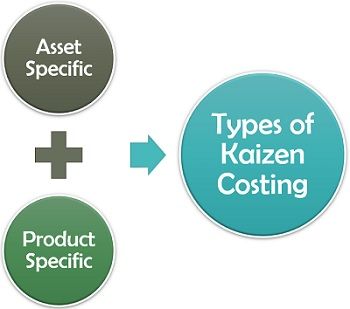
- Asset Specific: The asset and organization-specific kaizen costing focuses on the need for a particular deal or the business unit.
- Product Specific: The activity which is project or product-oriented, aiming at value analysis is termed as product-specific kaizen costing.
5S in Kaizen Costing
Workplace improvement, especially in the production or manufacturing unit, is not possible without the application of 5S kaizen technique. It involves the following five steps:
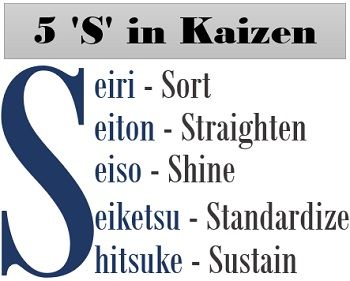
Sort (Seiri)
The first step in the 5S approach is categorizing the items based on their necessity. The unnecessary items should be labelled red and needs to be moved out of the organization. These items can be sold to the staff or as scrap else can be dumped by the organization.
Straighten (Seiton)
Now, the organization is left with essential items. These have to be arranged in an orderly manner for simplifying the operations. This step improves the visibility, availability and accessibility of all the tools and items.
Shine (Seiso)
Shine here refers to maintaining cleanliness in the workplace. It creates a positive work environment for the employees.
Standardize (Seiketsu)
One of the most vital tasks is to establish standards for cleanliness, usability and maintaining the placement of items in day to day business operations.
Sustain (Shitsuke)
The final step is to communicate and educate the employees about the changes made. Thus, developing a sense of self-control and discipline among them to maintain and follow the set standards.
Kaizen Costing Process
Now that we know about the kaizen costing, you must be wondering How is kaizen costing applied in real life?
To elaborate on the step by step procedure of practising the kaizen costing to enhance the efficiency of the business operations, read below:
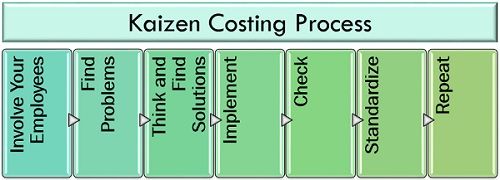
Involve Your Employees: The involvement of employees plays a vital role in implementing any change. The participation of employees and their feedback helps in generating ideas and information. It also eliminates the resistance to change from their side.
Find Problems: The organization together with its employees of all the departments (such as customer support, finance, human resource, production, design, etc.), needs to find out the various problems in the organization with the help of techniques like 360-degree feedback.
Think and Find Solutions: The next step is solving the identified problems. This step needs a lot of brainstorming and tactical approach; therefore, managers form a team of ingenious employees to find out a practical solution to each question.
Implement: Implementing any change involves cost and risk simultaneously. Therefore to be on a safer side, the new idea must be testified on a small part of the organization.
Check: The managers need to look after the proper implementation of the kaizen costing. That is, a new idea should not just remain in words; instead, it should be practically applied to the business process.
Standardize: After being satisfied with the results, the organization needs to set this change as a standard procedure for all the departments and across the whole organization.
Repeat: A standardized procedure becomes the organizational culture when continuously practised over a period.
Advantages of Kaizen Costing
When we talk about the benefits of kaizen costing, the first thing that clicks in our mind is that it improves business efficiency by reducing the various types of cost involved in running an organization.
The various advantages of kaizen costing are as follows:
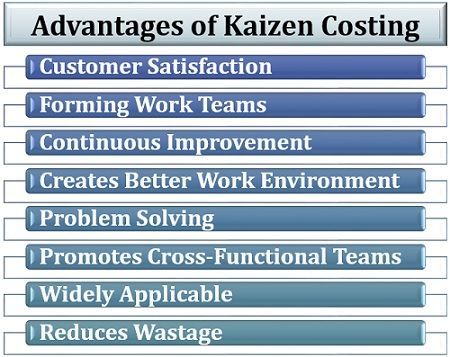
- Customer Satisfaction: The kaizen costing is a customer-oriented technique which focusses on providing better service to the consumers.
- Forming Work Teams: Every employee involved in the implementation of the kaizen practice needs to perform in a work team with a common aim of improvement.
- Continuous Improvement: Kaizen costing is a technique which emphasizes on improvement and betterment of the product, process, project and the organization.
- Creates Better Work Environment: It also promotes a positive work environment for the employees and the management. Like, sharing canteen and the dress code, is a part of work culture in many organizations.
- Problem Solving: One of the crucial functions of kaizen costing is to solve the identified problem to achieve perfection in business operations.
- Promotes Cross-Functional Teams: The teams so formed include employees with different skills and knowledge; thus, this technique encourages the formation of a cross-functional team.
- Widely Applicable: Kaizen costing is universally applicable to all kinds of organizations, whether it is service industry or manufacturing industry.
- Reduces Wastage: Due to better time management and material management in kaizen costing technique, the wastage of time and resources can be avoided.
Drawbacks of Kaizen Costing
Kaizen costing is a positive change process though there are some severe disadvantages of it which makes it a risky affair. Following are some of these:
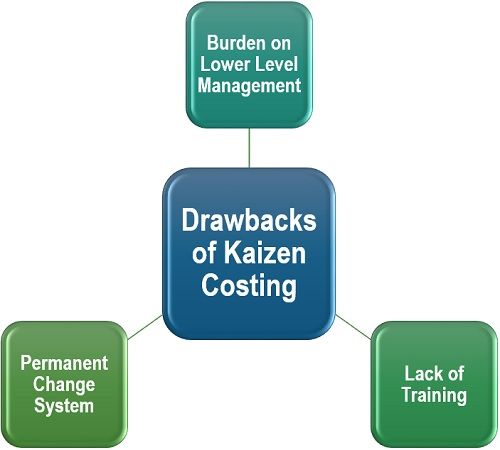
- The burden on Lower Level Management: It becomes confusing and tedious for the bottom level management to adopt the change in process or product so implemented through kaizen costing.
- Lack of Training: Kaizen costing requires a lot of expertise and training, and if not implemented strategically, it may even lead to adverse effects.
- Permanent Change System: The change so implemented through kaizen costing is irreversible, and it requires a lot of efforts and cost in withdrawing such decisions.
Example
Nestle is one of the most renowned foods and beverage company producing a wide range of products including baby food, dairy products, medical food, tea and coffee, snacks, confectionery, ice-creams, mineral water and many more.
The company used the kaizen costing technique for attaining lean production, and the approach was stated as Nestle Continuous Excellence (NCE).
In this process, Nestle addressed its problem of wastage and time consumed in the production to improve the efficiency of the company. Less wastage means incurring a low cost, better profit margin, high output and proper utilization of resources.
Nestle was able to reduce wastage in the production of FMCG and also successfully decreased the time consumed in the manufacturing of the products.
Leave a Reply